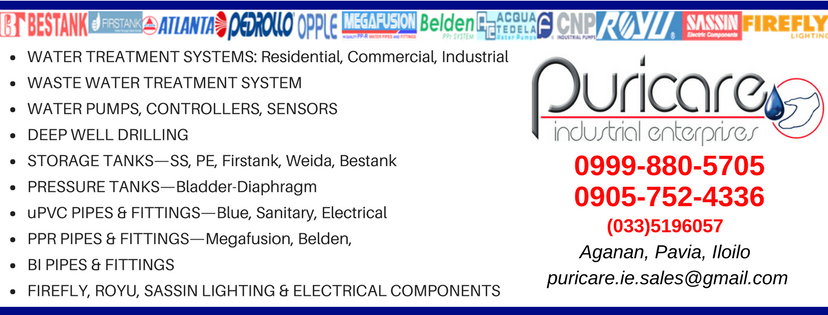PURICARE
INDUSTRIAL ENTERPRISES
 PURICARE
INDUSTRIAL ENTERPRISES started in 1992 as Puricare Home Products,
specializing in home water filters.
PURICARE
INDUSTRIAL ENTERPRISES started in 1992 as Puricare Home Products,
specializing in home water filters.
It
was reorganized under the name D’ Pure-Care Marketing in 2006 to meet the
demands for high quality water filtration needs of residential and commercial
industries. The venture proved to be successful. The number of satisfied
customers rapidly grew.
In
2012, the D’ Pure-Care Marketing was renamed PURICARE INDUSTRIAL
ENTERPRISES to satisfy the inexhaustible market for its services in water
filtration and purification, as well as distribution of state-of-the-art water
filtration equipment.
Now
on its 23th year in the Water Treatment Industry, PURICARE INDUSTRIAL
ENTERPRISES continues to meet the ever-growing and stringent needs of the
market. It stands by its promise to provide attractive, competitive prices,
quality products and after-sales services to its ever-growing clientele.
PURICARE
INDUSTRIAL ENTERPRISES does not rest on its laurels but continues to keep
itself abreast with the latest advances and the best technological approaches
in the Water Treatment Industry, thus living up to its espoused commitment to
its customers: “Safe Water at its Best.”
Puricare
Industrial Enterprises specializes in Water Treatment Technology. With its
extensive knowledge and skills, Puricare caters to the various needs
of its clientele at the following levels:
* INDUSTRIAL -
boiler plants pre-treatment, hospitals, food preparation, beverage production, dialysis
machine pre-treatment, etc.
* COMMERCIAL – spas, swimming pools,
resorts, water refilling stations (U. S. equipment only)
* RESIDENTIAL - including treatment
of water distribution systems for apartments, condominiums, subdivisions,
barangays
Using
state-of-the-art water treatment systems featuring automatic and programmable
controls, Puricare Industrial Enterprises designs, installs,
commissions and maintains equipment like the following:
* Multi-media
water filters
* Reverses osmosis modules
* Ultra violet bactericidal lamps
* Transfer pumps
* Automatic pump controls
* Chemical feed pump
* Fibreglass pressure tanks
* Storage tanks
With
its committed after-sales technical support, Puricare Industrial
Enterprises has established a name for itself in the Water Treatment
industry, thus, earning the trust, confidence and respect of contended and
satisfied clients.
Also, Puricare
Industrial Enterprises has designed, installed and maintains hundreds of
water treatment systems, including those in homes of foreign nationals and
prominent people in the region.
Puricare
now carries other lines of services, equipment and hardware to serve the needs
of its clientele:
-
CENTRALIZED WATER TREATMENT SYSTEMS
Reverse Osmosis, Multimedia/Carbon Filters, Softeners, UV
Reverse Osmosis, Multimedia/Carbon Filters, Softeners, UV
-
ADVANCED OXIDATION WASTE WATER TREATMENT SYSTEM
-
DEEP WELL DRILLING
-
BESTANK STORAGE & PRESSURE TANKS, Stainless Steel, Plastic Storage &
Fiberglass Pressure Tanks
-
ATLANTA uPVC PIPES & FITTINGS—Blue, Sanitary, Electrical
-
MEGAFUSION PPR PIPES & FITTINGS
-
BI PIPES & FITTINGS— Fire Protection Sprinkler Systems
-
FIREFLY, ROYU, SASSIN LIGHTING & ELECTRICAL COMPONENTS
-
WATER PUMPS, CONTROLLERS, SENSORS, Transfer, Booster, Submersible, Multi-Stage Pumps
Aganan,
Pavia, Iloilo
09998805705 / 09057524336
(033) 5196057
09998805705 / 09057524336
(033) 5196057
e-mail: puricare.ie.sales@gmail.com























